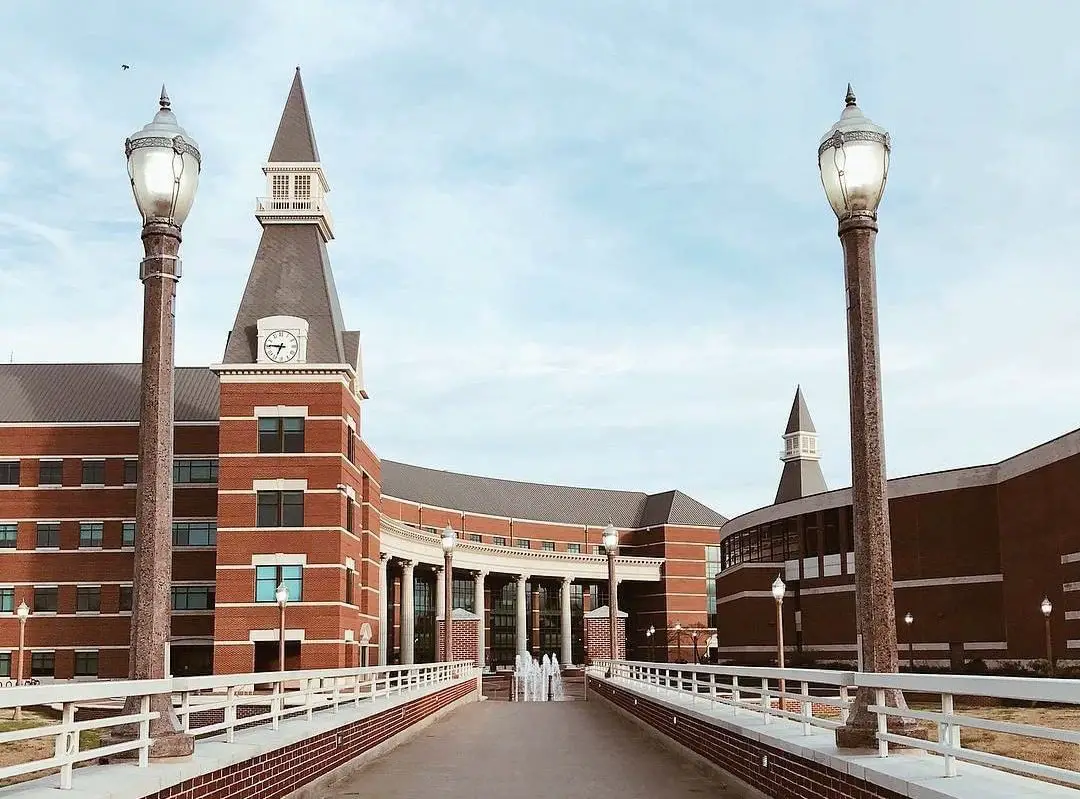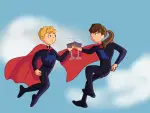I keep snapshots of a small, old-fashioned diner in Santa Ana, California tucked away with some of my happiest memories — falling in love for the first time over butter-smothered pancakes, forging lifelong friendships while sipping Cherry Cokes and celebrating finishing AP Exams with onion rings. Pop’s Café was the ultimate stop before, after and during class (with or without our teacher’s permission) during my years at the Orange County School of the Arts (OCSA), a charter school — a liberal arts school.
High school somehow flew by and dragged on at the same time, until I found myself heading off to college into a completely different universe: Baylor University, a private Baptist university in Waco, Texas.
https://www.instagram.com/p/BTU2nfiB2A5/?utm_source=ig_web_copy_link
There was something quite charming about attending a high school dispersed throughout a busy city, a seven-story building that held most of our academic classes, an old church with a basement made for a bookworm and a theater that upperclassmen drove to because it was inconveniently far from the rest of the campus.
I woke up almost every day before 6 a.m. to get ready for school and ate a fast breakfast during a 45-minute carpool ride in order to attend the artsy kid high school that would keep me away from my home until 6 or 6:30 p.m.
Even though I had little free time during the weekdays and barely slept, it was worth it to me, as well as to some of my peers, who rode trains for up to two hours to get to school.
The curriculum and workload made our liberal arts school unique. After a full day of academic classes with the same core curriculum as all the other high schools in California, we moved on to one or two classes related to our chosen area of study of conservatory.
Incoming students had to audition for their preferred conservatory before they could be admitted, which covered a range of artistic mediums. We had conservatories for types of dance, music, theater, film and visual arts that one would expect alongside some surprise studies like production and design, digital media or culinary.
I was a part of the creative writing conservatory. We had four required classes when I began my freshman year: core creative non-fiction, core short story, core screenwriting and core poetry. I took most of these classes while I was an underclassman and met some of my best friends in the liberal arts school workshopping our writing.
We also had several other classes to choose from, ranging from playwriting, spoken-word poetry, author studies on writers like Sylvia Plath and Dean Koontz, and genre studies on topics like Norse mythology and zombie literature. These classes were demanding, but, overall, they took a backseat to our regular academic curriculum.
When I first share with people about my high school experience, most people assume life was like an episode of “Victorious” or “High School Musical.” However, my high school experience was pretty typical if you replace competitive sports teams with musical theater and dance groups, and if you add regular, undisputed pride day and LGBTQIA+ celebrations.
At first, I was oversaturated with acceptance coming from a relatively conservative neighborhood. It was all new to me to see same-sex couples comfortably showing physical displays of affection, students dressed in glorious drag for Halloween (or just a regular Thursday) and rainbow-colored paint smudged on every single student’s cheeks.
Our LGBTQIA+ community was so prominent in our liberal arts school that I learned about same-gender sex in health class and a street preacher even stood outside our campus during Welcome Week filming us at lunch as he shouted a mix of profanity and Bible verses.
I learned how to be more open minded from my peers than I could have ever learned from parents or other adults, but I still felt like our school had a long way to go. As a liberal arts school, we had a limited number of religious students. Whether they were practicing Christians, Muslims, Jews, Hindus or from any of the other religions from around the world, students were not very open about their religious views.
Before high school, I was somewhere between a holiday Christian and a regular Christian churchgoer when it came to religion. At OCSA, I began to feel more of an urgency to have pride in my beliefs and live life through God. I found small pockets of fellow Christians as well as friends from other belief systems through lunchtime clubs.
Although most of my friends from religious clubs were not surprised when I choose to attend Baylor University, my other friend groups at my liberal arts school were shocked that I would even consider a Baptist university in the typically conservative South.
I shocked myself in some ways, too. I always planned on attending some liberal arts college with brick buildings covered in ivy somewhere on the east coast, and Baylor was so different from that. But I fell in love with the school as soon as I toured the campus.
I lived in Texas when I was in elementary school for about a year because of my dad’s role in the military, and my whole family wanted to return. Something about the Lone Star State pulled us toward it without really giving us a precise reason why. We just loved Texas.
Baylor, also, had a huge emphasis on faith, which was a stark contrast to my experience with religion at my high school. Our core curriculum included two classes focused on Christian texts and history as well as two semesters of required 45-minute chapels. (The only way you could fail chapel was missing more than a certain amount of days, and I failed it once, so I had to take it for three semesters.)
Another huge difference I noticed by the end of my first day at Baylor was in showing school spirit. In high school, we had spirit weeks, where we dressed up to match different themes, but that was about it. I do not remember a school mascot in high school — it could have been a star or a rainbow or something like that — but our school motto, “We are OCSA,” left much to be desired.
From throwing “Sic ‘Ems” and screaming supportive chants for our student athletes to two live bear mascots in an enclosure on campus, Baylor runs on school spirit. There’s also a deep-rooted connection between every single generation at Baylor that forges ties between strangers around the world, just because they are wearing green and gold merch.
This emphasis on school spirit, of course, originates from old traditions, as old as the oldest university in Texas and sports like football and basketball. Students show the most spirit when they are watching our Lady Bears or the Baylor Bears football team defeat our rivals in person.
On game days as well as school days, waking up in the mornings has been a lot easier for me than it was in high school. When I lived in the dormitories on campus, I could simply walk to all my classes, and now that I live in an off-campus apartment, the drive or bus ride is still no more than five minutes.
I can cut it close when waking up now, which is something I could never really do before. Instead of wearing unique, vintage dresses and heels every day like I did in high school, I turned to the typical collegiate uniform of an oversized T-shirt with sweatpants or leggings.
Although an entertainment journalism class and a year on the staff of our newspaper, Evolution, in high school motivated me to study journalism at Baylor, I never learned much about writing journalistic pieces. In high school, our main focus most of the time was creating stories rather than unbiasedly telling them.
As a now junior, majoring in journalism with a concentration in news editorial, I have taken a range of different classes meant to prepare me for the newsroom. Additionally, all of my time not spent in a classroom I’ve dedicated to the Baylor Lariat’s newsroom, running on coffee and the dogeared pages of my AP Stylebook.
While working on our newspaper, however, I witnessed and learned things about Baylor University that sometimes can be difficult to swallow.
The controversies most people think of are the sexual assaults and how they are handled at Baylor. Every week, the Lariat staff reads and publishes our campus crime and fire log in compliance with the Clery Act.
The treatment of the LGBTQIA+ community at Baylor was even more of a culture shock for a student like me, coming from a school that did not really have an LGBTQIA+ club unless you count the entire student body.
Baylor refuses to allow LGBTQIA+ groups on campus based on their Student Policies and Procedures’ Statement on Human Sexuality, which denounces “homosexual behavior” as “contrary to biblical teaching.” When I last left Baylor at the beginning of summer, two different petitions circulated online: one that was for LGBTQIA+ groups on campus and another that was against it.
Still a huge debate amongst Baylor students and faculty as the new year school year begins, the argument relies on students’ views of freedom of speech and the university’s commitment to sticking to their values and giving a traditional Christian education.
Baylor is not completely drained of gay pride. I have many peers who openly identify as something other than cis or heterosexual, and we even have an underground LGBTQIA+ club that is neither chartered or approved by our university.
My shift from an extremely open-minded and unapologetic LGBTQIA+ environment to one where gay is still used as an insult and students keep their identities secret was like going from an icy pool to a hot, bubbling jacuzzi, but it taught me so many things that will help me in my life and career.
I learned how to communicate, argue and compromise with the loudest of the Democrats and the sternest of the Republicans, as well as most other political views in the U.S. I have had heart-to-hearts with Christians, Muslims, atheists, Wiccans and people of many different faiths and beliefs. I have befriended both line-dancing, party-throwing, cowboy boot-wearing churchgoers and gay artists sporting fishnets and a hand-rolled joint.
Most importantly, I found a balance in my own life and political and religious beliefs that work for me. I built it from my personal experiences in both environments, with all their faults and strengths combined. I love OCSA and Baylor, and I love what makes them different.
















